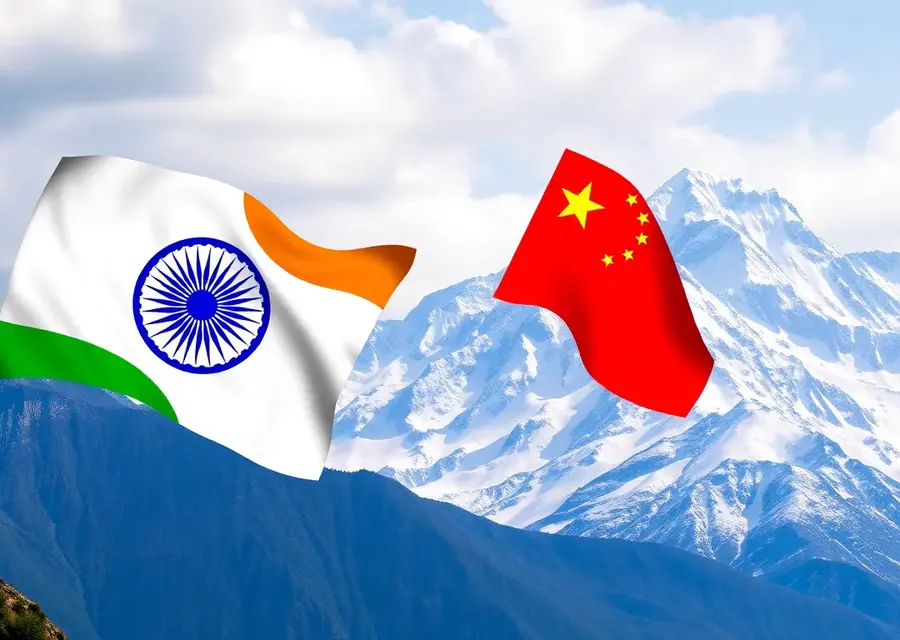India China Relations: Mending Ties Amidst Global Shifts
- THE MAG POST

- Aug 22
- 6 min read

India and China have recently signaled a significant thaw in their relationship, agreeing to boost trade and resume direct flights, a move that could reshape the geopolitical landscape of Asia. This diplomatic breakthrough comes after a period of strained relations, notably following a deadly border clash in 2020. The willingness of these two Asian giants to mend ties is occurring against a backdrop of shifting global alliances and economic pressures, particularly influenced by the trade policies of the Trump administration. The implications of this renewed engagement extend beyond bilateral trade, potentially impacting regional stability and international economic dynamics.
The impetus for this reconciliation appears multifaceted, with both nations seeking to navigate a complex international environment. The renewed focus on resolving their longstanding border dispute, alongside practical steps to improve trade and travel, suggests a shared understanding of the benefits of cooperation. As India and China move to rebuild their relationship, the world watches closely to see how this diplomatic recalibration will influence broader global economic and political trends, especially concerning their interactions with other major powers.
India and China Mend Ties Amidst Geopolitical Shifts
In a significant diplomatic maneuver, India and China have publicly declared their intention to bolster trade relations and reinstate direct flight services. This development signals a concerted effort by the world's two most populous nations to mend fences, particularly in the wake of a fatal border skirmish in 2020 and in the context of evolving global political dynamics. The agreement to enhance trade flows and resume flights marks a pivotal moment, potentially reshaping regional alliances and economic strategies.
Addressing the Border Dispute: A Step Towards Reconciliation
A crucial aspect of the recent diplomatic engagement between India and China involves the commitment to advance discussions on their long-standing border dispute. This renewed focus on resolving territorial disagreements is a testament to the growing imperative for stability in the region. The agreement to move forward with border talks, coupled with specific measures to de-escalate tensions along the Himalayan frontier, underscores a shared desire to prevent future conflicts and foster a more peaceful coexistence.
Facilitating Troop Withdrawal and Border Management
The discussions between India and China have yielded concrete agreements concerning the phased withdrawal of tens of thousands of troops stationed along their shared Himalayan border. This strategic repositioning of military forces is intended to reduce the risk of accidental escalation and create a more conducive environment for diplomatic engagement. The commitment to withdrawing troops is a visible sign of de-escalation, aiming to restore normalcy to the border regions.
Furthermore, the establishment of an expert group to explore 'early harvest' agreements for improved border management represents a pragmatic approach to addressing immediate concerns. These mini-agreements are designed to be implemented quickly, building confidence and laying the groundwork for more comprehensive resolutions. India's prior reluctance to such phased agreements highlights the significance of this new collaborative step.
Reopening Trade Routes and Boosting Economic Exchange
A tangible outcome of the renewed diplomatic engagement is the decision to reopen key trading routes, including the Lipulekh Pass, Shipki La Pass, and Nathu La Pass. This reopening is expected to significantly boost bilateral trade, facilitating the movement of goods and strengthening economic ties between the two Asian giants. The restoration of these vital arteries of commerce is poised to inject new vitality into their economic relationship.
Beyond the reopening of specific passes, there are indications that China may address India's concerns regarding export restrictions on critical commodities such as fertilizers and rare earth minerals. While official confirmation from China on these specific measures is pending, the willingness to discuss such issues signals a potential easing of trade-related friction and a commitment to ensuring the stability of global supply chains.
Diplomatic Engagements and Statements of Intent
The recent high-level meetings between Indian Prime Minister Narendra Modi and Chinese Foreign Minister Wang Yi have been instrumental in shaping the current diplomatic trajectory. These encounters have set the stage for future engagements, including Prime Minister Modi's upcoming visit to China. The exchange of views and the reaffirmation of mutual interests are crucial for building trust and fostering a stable bilateral relationship.
Both leaders have expressed optimism about the future of India-China relations, emphasizing the importance of peace, stability, and cooperation for regional and global prosperity. Prime Minister Modi's statement on X (formerly Twitter) highlighted the contribution of stable ties to peace, while National Security Adviser Ajit Doval noted the achievement of a new environment of peace and tranquility. These statements reflect a shared commitment to moving past recent difficulties and building a more constructive relationship.
Historical Context: The 2020 Border Clashes and Their Aftermath
The current efforts to mend ties between India and China are deeply influenced by the events of 2020, when a deadly clash along the Line of Actual Control (LAC) resulted in significant casualties on both sides. This confrontation marked the most severe violence between the two nuclear-armed neighbors since 1975, leading to a freeze in high-level diplomatic relations and a substantial military buildup in border areas.
The aftermath of the 2020 clashes saw a chilling effect on various aspects of the bilateral relationship, including trade and air travel. India's response included imposing restrictions on Chinese investments and banning several Chinese mobile applications, citing national security concerns. Despite these tensions, bilateral trade continued to grow, underscoring the deep economic interdependence between the two nations, particularly in sectors like electronics and pharmaceuticals.
Trump's Trade Policies and the India-China Realignment
The geopolitical landscape shaped by Donald Trump's assertive trade policies has inadvertently created an opportune moment for India and China to recalibrate their relationship. The imposition of steep tariffs by the Trump administration on both India and China, particularly affecting India's trade with the US, has prompted New Delhi to re-evaluate its strategic partnerships and explore avenues for rapprochement with Beijing.
The friction in India-US relations, exacerbated by trade disputes and differing stances on geopolitical issues, has pushed India to seek greater stability with China. This strategic realignment is viewed by some as a necessary adaptation to a changing global order, where traditional alliances are being tested. The perceived double standards in US tariff policies have further fueled this reassessment, prompting India to seek a more balanced approach to its international relations.
The Final Solution: A Path Forward for India and China
The recent diplomatic overtures between India and China represent a critical juncture, driven by a confluence of border stability needs and the broader geopolitical realignments influenced by global trade dynamics. The agreements to enhance trade, resume flights, and address the border dispute are significant steps toward rebuilding trust and fostering a more cooperative relationship. While challenges remain, the renewed commitment to dialogue and pragmatic problem-solving offers a promising path forward for both nations, potentially contributing to enhanced regional peace and economic prosperity.
Key Agreements and Developments | Details and Implications |
Resumption of Trade Ties and Direct Flights | India and China agree to step up trade flows and reinstate direct flights, aiming to normalize relations post-2020 border clashes. This facilitates economic exchange and people-to-people contact. |
Border Dispute Resolution Efforts | Commitment to advancing talks on the disputed border, including troop withdrawal and enhanced border management through an expert group for 'early harvest' agreements. |
Reopening of Trade Passes | Key border passes like Lipulekh, Shipki La, and Nathu La will be reopened, expected to boost bilateral trade and economic cooperation significantly. |
Addressing Trade Concerns | Potential Chinese action on India's concerns regarding export curbs on fertilizers and rare earth minerals, signaling a willingness to ease trade friction. |
High-Level Diplomatic Engagements | Meetings between PM Modi and FM Wang Yi set the stage for future interactions, emphasizing peace, stability, and cooperation for regional prosperity. |
Impact of US Trade Policies | Geopolitical shifts driven by US tariffs under Trump have created an opening for India and China to mend ties, especially amidst US-India trade friction. |
Post-2020 Border Clashes Context | The 2020 clashes led to a freeze in diplomatic relations and military buildup, impacting trade and travel, though bilateral trade continued to grow. |






















































Comments